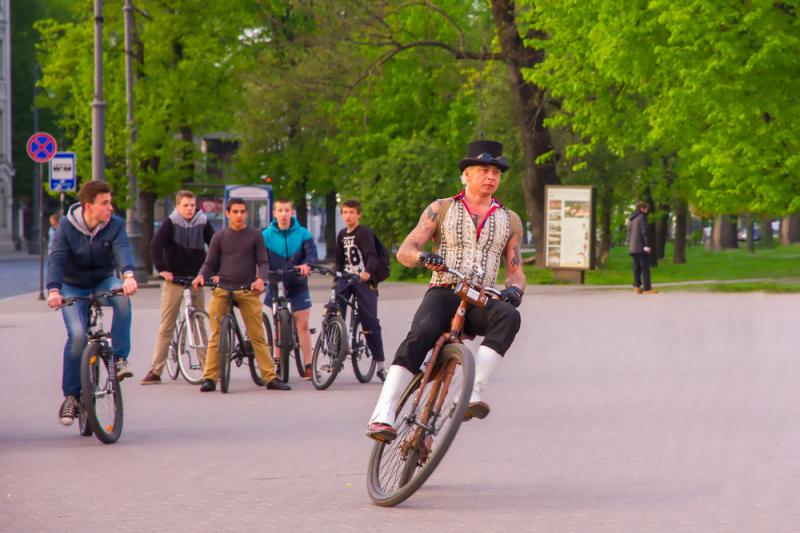The Vilnius urban infrastructure project should make Lithuania’s capital safer
It was a warm Tuesday evening in Vilnius, last June. The air was around 20 degrees Celsius and dry. A perfect night for biking. The sun sets late up there in the summer, so there was still twilight. But it wasn’t bright enough for a 24-year old man pedalling on a bike-route off T. Narbuto Street. He didn’t notice, hidden on the roadside, a small sign advising bikers to keep slightly left. If they didn’t, they’d hit a staircase.
That’s what happened to the 24-year old. He died as a result of the injuries he suffered that night. Vilnius was shocked. A staircase in the middle of a bike route!
“I still can’t believe bike paths are being designed by people who don’t ride bikes. Unfortunately, bad quality and stupidity in designing and building bike paths are still common,” Remigijus Šimašius, the city’s mayor, posted on his Facebook account. He was elected into the office just two months earlier and had no problem with criticism where it was due. But he also made a promise: “I have many concrete plans in this area.”
Part of this promise is now taking shape with the help of a EIB loan for a large-scale, five-year Vilnius urban infrastructure development project. The total EUR 410 million project will include a number of small investments in various schools, nurseries and kindergartens, museums, public gardens and other public areas, roads, healthcare facilities etc.
But it will also include projects to construct 17.4 kilometres of new bicycle paths. There will be more and better signs and better surfaces, including on T. Narbuto Street where the fatal accident took place.
2 out of 3 lights turned off
Gintare Kavaliunaite, who works at the European Humanities University in Vilnius, says a big reason she doesn’t bike is that there haven’t been enough bike routes to make the journey safe. “Often you have to bike on a busy street, and the drivers in Vilnius are not careful enough,” she says. “The bike routes we do have are usually drawn on sidewalks. They’re not comfortable for the bikers or pedestrians. They tend to end suddenly in unexpected places.”
Vasco Amaral Cunha is the EIB loan officer for the public sector in the Baltic States and Poland. He puts this project into perspective. “Vilnius was hit hard by the financial crisis. The city has faced very demanding financial conditions in the past years and I am happy that we are helping Vilnius in its effort to improve its financial situation.” Now, the new city administration is trying to change things. It aims to use the EIB financing also as an argument to refinance their existing, more expensive short-term obligations with private banks.
A few years back, the city had to stop paying its suppliers. Vilnius natives remember how, during the financial crisis, the city started to keep only one streetlight out of every three turned on. It saved money. “But this made the city much darker and didn‘t feel safe and cosy anymore,” Kavaliunaite says.
Sigitas Mocevičius, director of the city-owned company Vilniaus gatvių apšvietimo elektros tinklai which operates the streetlights, says the current state of the streetlight system is hugely inefficient. 90% of the lamps are sodium-vapour lamps. Think yellow (but hip!) East Berlin versus fluorescent West Berlin. Installed more than 16 years ago, they are at the end of their economic lifespan and are environmentally unfriendly. The lamp posts are outdated. Every third one is more than 30 years old. This poses real physical dangers, as the poles could start falling down, even though the city has been careful to replace the most critical ones, Mocevičius says.

People, some on creative bikes, gathered in Vilnius in March for a large annual folk arts and crafts fair
Besides the bike routes and the construction of a major bypass road around Vilnius, the partly EIB-funded investment programme’s one other major project will be the improvement of the streetlights.
“We expect to have LED lights, an online failure-monitoring system and reduce energy consumption by no less than 50%,” says Mocevičius. “And increased safety on the streets.“
He is not only referring to safety from the danger of having a lamp pole crash on you. Improved street lighting decreases crime. A 2007 study conducted for the Swedish National Council for Crime Prevention concludes that “improved lighting led to a significant 21 percent decrease in crime in experimental areas compared with comparable control areas.” The study suggests the main reason is not increased fear among criminals that they will be found out. Rather it’s a less obvious one. Improved lighting signals to the community that investments are being made in the city. That leads “to increased community pride, community cohesiveness, and informal social control.”
Happiest city in Europe?
Vilnius police buy into this theory. “The experience explicitly confirms that the improvement of city lighting will have a substantially positive effect on crime rate, so there is no doubt that the project will significantly contribute to the reduction of crime level and will provide greater sense of security,” a spokesman for Vilnius county police says.
Andrius Sokolovskis, a Vilnius-born EIB loan officer, is very optimistic about the impact the project will have on his home-town. “I’m extremely happy to be a witness to how the city has been developing during the last three decades, from the country’s restoration of independence in 1990 to becoming the happiest city to live in Europe,” he says.
Eurostat, in September this year, published results of a survey showing 98% of Vilnius residents are satisfied with life in their city. That’s the highest rate of any capital in the EU. If increased community pride does help make a city safer, Vilnius is on the right track.
